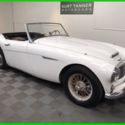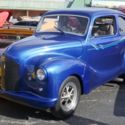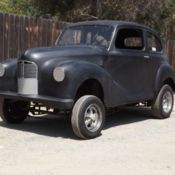RARE 1950 Austin of England Atlantic Sports Saloon A90-Not Dorset Devon Healey
- Make: Austin
- Model: Atlantic Sports Saloon
- Type: Coupe
- Trim: A90
- Year: 1950
- Mileage: 33533
- VIN: BE2L78941
- Color: Black
- Engine size: 162 cu in
- Number of cylinders: 4
- Fuel: Gasoline
- Transmission: Manual
- Drive type: RWD
- Vehicle Title: Clean
- Location: Fresno, California, United States
Description
Here's a very rare Austin Atlantic that is mostly complete. It's been sitting in a warehouse for a very long time so we're not sure if the engine turns. As you can see, she does have rust but you rarely see these in United States so someone might want to consider restoring this car or building a one-of-a-kind hot rod. Most people have never seen one here this is a chance to own something totally unique. We have a clear California title and delivery is available, message me for a quote.SEE OUR COMPLETE INVENTORY AND MORE PICTURES AT RARE AUSTINS DOT COM.
We have thousands of new and used parts, more than anyone in the U.S. so we can help with what you may need to build this car!
Here's some additional information on the Atlantic:
The Austin A90 Atlantic is a British car that was produced by the Austin Motor Company from 1949 to 1952. It was launched initially as a four-seat convertible, making its début at the 1948 Earls Court Motor Show in London, with production models built between spring 1949 and late 1950. A two-door coupé, marketed as the A90 Atlantic Sports Saloon, followed a year later. It had been previewed at the 1949 Motor Show and was in production at Longbridge between 1950 and 1952.
The Atlantic was one of the first post-war cars engineered from scratch by Austin, and was said to be styled from a thumbnail sketch by Leonard Lord, then Chairman of Austin and later the British Motor Corporation (BMC) — though in truth the styling was more likely the work of resident Argentinian Austin stylist Dick Burzi. The car was almost certainly influenced by a 1946 Pininfarina-bodied Alfa Romeo cabriolet, which just happened to end up at the Longbridge factory in mid-1947, a few months before the light blue 16 hp sports prototype made its first appearance in the experimental department and on nearby roads around the factory. A rare edition was a coach built estate car, regularly seen in the 1950s used by a convent in Leith, Scotland. The car had a lifting rear door, and sported then unusual curved "perspex" roof panels.
With the then Government edict of "Export or die" and steel allocated only to those who generated much needed dollar revenue, the Atlantic was designed specifically to appeal to North American tastes (certain aspects look like a 1949 Mercury and the bonnet (hood) brightwork looks similar to the Pontiac Chieftains of this era). The car featured up-to-the-minute detailing, with a wrap around windscreen, composed of a flat glass center section with, tiny curved end panels. The front wings (fenders) sported twin 'Flying A' hood ornaments and swept down to a rounded tail, with spats enclosing the rear wheels. A centrally mounted third, main beam, headlight was built into the letter-box style air intake grille, and the then unheard of luxury of hydraulically powered windows and hood (convertible top), "flashing indicators" (blinkers) rather than trafficators, (for the United States market at least) and the option of EKCO or HMV Autocrat radios. The range-topping Austin was offered in a variety of "jewelescent" colors with names like 'seafoam green' and 'desert gold' but few of these brave new metallics were sold in the UK market. The convertible, a three window, drophead coupe had a simple fabric top, without rear quarter lights (opera windows), which butted up to the rear of a rather thick windscreen header rail. The fixed head, five window, Sports Saloon (hardtop), could be had with its roof painted or covered in fabric. This gave it the popular 'drophead or cabriolet' look; all the style with no leaks. Many photographs of this car are wrongly titled, due to observers confusing the fabric covered hardtop for a convertible. As its final party trick, the center section of the three piece, wrap-around, rear window, could be lowered into the boot (trunk), for added ventilation by a remote winder above the front windscreen. Few people in the car's native Britain would have ever seen anything like the futuristically-styled Atlantic before, and certainly not from a conservative mainstream manufacturer like Austin. The radical Atlantic suffered, however, from the dramatically new Jaguar XK120, also launched at the 1948 Motor Show.
Out of a total production run of 7,981 only 3,597 were exported, and just 350 of which were to the US. This low level of sales in the US was despite a huge focus by Austin, including a successful attempt at breaking 63 stock car records at the Indianapolis Motor Speedway in April 1949 by Alan Hess, Charles Goodacre and Dennis Buckley and a US$1000 price reduction in 1949, the four-cylinder 2.7-litre couldn't compare in power output to native V8 engines — although, for its time, performance was strong. A few were also used in civilian versions of the Austin Champ.
The car did see more success in former British Colonies, Europe, Scandinavia and Australasia
The Atlantic was powered by an engine based on the proven Austin A70 OHV engine design, but increased to 2,660 cc (162 cu in). The large four-cylinder produced 88 bhp (66 kW) @ 4000rpm[4] and later saw service in the Austin-Healey 100.
A convertible tested by the British magazine The Motor in 1948 had a top speed of 91 mph (146 km/h) and could accelerate from 0-60 mph (97 km/h) in 16.6 seconds. A fuel consumption of 21.7 miles per imperial gallon (13.0 L/100 km; 18.1 mpg‑US) was recorded. The test car, which had the optional hydraulically powered top and window operation (£40 extra), cost £824, including taxes.
The handling was average, but adequate for the era, with coil independent suspension at the front and leaf springs at the rear, employing lever arm shock absorbers or 'dampers' which, when worn, resulted in a characteristic 'wave motion' over undulating surfaces. The underpinnings were somewhat less exotic than the all-enveloping bodywork: the chassis and running gear were based on that of the well-proven 1949 Austin A70 Hampshire saloon (not to be confused with the smaller entry level A40 Devon). Brakes were initially a mix of hydraulic (front) and mechanical (rear) with 11 in (279 mm) drums, replaced by a fully hydraulic brake setup from 1951 onwards on the hardtop coupe (saloon) which with large diameter finned drums and vented wheels. This made for efficient anti-fade braking for the time, necessary to bring 26cwts (1323.64 kg) to rest.
The lack of factory rust proofing and styling that produced a multitude of mud traps led to rapid corrosion commonplace among many rushed post-war British designs. As a consequence of this and many Atlantics being broken up to provide spares for the Austin-Healey 100 very few examples survived into the 1970s, let alone the next century. In the UK today, it is estimated that fewer than 60 survive, half of them roadworthy.
From Wikipedia, the free encyclopedia
ExteriorInteriorEngineCreated on the eBay Motors app
More Austin classic cars for sale
 1958 AUSTIN HEALEY 100-6 BN-4 SPORTS ROADSTER. VERY DECENT CAR FOR IMPROVEMENT.
1958 AUSTIN HEALEY 100-6 BN-4 SPORTS ROADSTER. VERY DECENT CAR FOR IMPROVEMENT.
 Austin Devon
Austin Devon
 1948 AUSTIN DORSET 2DR STREET ROD HOT ROD
1948 AUSTIN DORSET 2DR STREET ROD HOT ROD
 1948 Austin Dorset for sale!
1948 Austin Dorset for sale!
 1949 Austin Devon
1949 Austin Devon
 Austin A40 Devon LHD sedan
Austin A40 Devon LHD sedan
 1951 Austin A40 Devon
1951 Austin A40 Devon
 1948 Austin Dorset Gasser, Project Car, Rat Rod,
1948 Austin Dorset Gasser, Project Car, Rat Rod,
 1966 Austin Healey 3000 Mark III Sports Convertible Survivor Type
1966 Austin Healey 3000 Mark III Sports Convertible Survivor Type
 1966 AUSTIN HEALEY 3000 MK3 BJ-8 SPORTS CONVERTIBLE SUPERBLY SOLID AND RUSTFREE.
1966 AUSTIN HEALEY 3000 MK3 BJ-8 SPORTS CONVERTIBLE SUPERBLY SOLID AND RUSTFREE.
 1958 AUSTIN HEALEY 100-6 BN-4 SPORTS ROADSTER. VERY DECENT CAR FOR IMPROVEMENT.
1958 AUSTIN HEALEY 100-6 BN-4 SPORTS ROADSTER. VERY DECENT CAR FOR IMPROVEMENT.
Year: 1958
Mileage: 4,641
Mileage: 4,641
 Austin Devon
Austin Devon
Year: 1950
Mileage: 1,234,567
Mileage: 1,234,567
 1948 AUSTIN DORSET 2DR STREET ROD HOT ROD
1948 AUSTIN DORSET 2DR STREET ROD HOT ROD
Year: 1948
Mileage: 12
Mileage: 12
 1948 Austin Dorset for sale!
1948 Austin Dorset for sale!
Year: 1948
 1949 Austin Devon
1949 Austin Devon
Year: 1949
Mileage: 26,000
Mileage: 26,000
 Austin A40 Devon LHD sedan
Austin A40 Devon LHD sedan
Year: 1950
Mileage: 88,394
Mileage: 88,394
 1951 Austin A40 Devon
1951 Austin A40 Devon
Year: 1951
Mileage: 53,598
Mileage: 53,598
 1948 Austin Dorset Gasser, Project Car, Rat Rod,
1948 Austin Dorset Gasser, Project Car, Rat Rod,
Year: 1948
Mileage: 1,775
Mileage: 1,775
 1966 Austin Healey 3000 Mark III Sports Convertible Survivor Type
1966 Austin Healey 3000 Mark III Sports Convertible Survivor Type
Year: 1966
Mileage: 62,842
Mileage: 62,842
 1966 AUSTIN HEALEY 3000 MK3 BJ-8 SPORTS CONVERTIBLE SUPERBLY SOLID AND RUSTFREE.
1966 AUSTIN HEALEY 3000 MK3 BJ-8 SPORTS CONVERTIBLE SUPERBLY SOLID AND RUSTFREE.
Year: 1966
Mileage: 95,708
Mileage: 95,708












